Seminar about Feral Atlas
In this class we learned about some field reports on Feral Atals through examples, our group analysed the case of underwater noising, and as we delved into the anthropological issues of anthropogenic noise on marine life, we couldn’t help but think about the huge impact that human activities have on the natural environment. As human society develops, our demand for natural resources continues to grow, and this has led to the destruction of the natural environment by human activities. Amongst other things, underwater noise, a by-product of human activity, is also constantly affecting the survival and reproduction of marine life.


From an anthropological standpoint, we must acknowledge that people are cultural beings in addition to being biological beings. How we view and use the natural world and its resources is directly influenced by our cultures and lives. Therefore, we must consider how we may preserve our traditions and way of life while minimizing harm to the environment and doing everything we can to safeguard and maintain its balance and stability.
But while I watched these reports, I could not help but wonder: Why are all of these examples about how badly people have affected the environment?

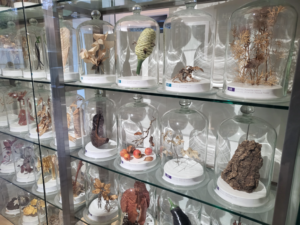
In the last week I visited the Royal Botanic Gardens in Edinburgh, where plants from all over the world have been brought in from an anthropological point of view, which sounds like colonialism because we don’t know if the plants themselves want to do this, but the aim of scientists is not to generate income for ornamental or economic purposes, but to do scientific research to make a particular plant more suitable for survival, and if an Anthropocene report like this is done, then this must It must be a positive impact. In the class Linda answered my question by saying that we need to think critically and that we can’t single out a project as right or wrong before we do it, this is also bad for the development of research.
Academic poster
As part of my academic poster exercise, I intended to do fieldwork to explore the community graffiti culture in the city of Edinburgh, my plan was to walk from the ECA to Laurison Square, then to Princes Street and the Royal Mile and back.Along the way I discovered that there was a lot of graffiti that had a specific style and they were not painted in a random way, which piqued my interest very much.
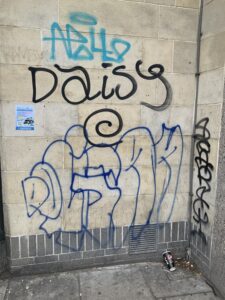
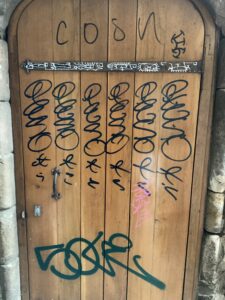
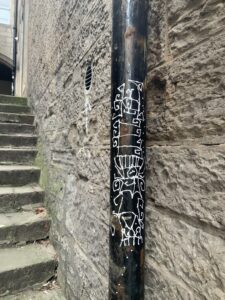



I ran into difficulties when I couldn’t find any literature on graffiti culture in the Edinburgh city area. One night I waited in a bridge hole for a graffiti artist to come and do an interview, but no one showed up. After this, my mentor advised me not to continue with this dangerous act. As a result, I changed my approach and decided to study the environmental impact of graffiti materials. I found out that these materials are very unfriendly to the environment, releasing volatile substances that cause ecological and atmospheric pollution and damage to buildings.
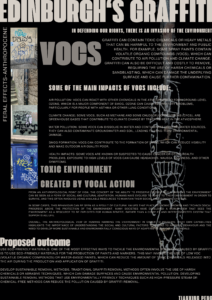
Academic Poster:Edinburgh‘s Graffiti

